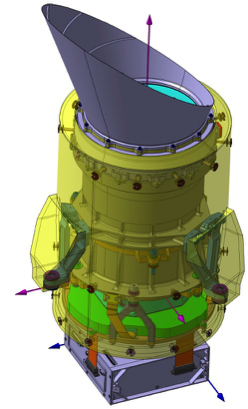 Each of the 24 normal and 2 fast cameras includes:
Each of the 24 normal and 2 fast cameras includes:
- the Telescope comprised of
- the Telescope Optical Unit (N-TOU and F-TOU)
- the Focal Plane Assembly (FPA) holding 4 CCD detectors
- the Front End Electronics (N-FEE for N-CAM and F-FEE for F-CAM).
- the Ancillary Electronics Units (AEUs):
- the FEEs of the 24 N-CAM are powered by two AEUs that also provide synchronisation signals for simultaneous read-out across cameras.
- a separate unit (F-AEU) provides power for the Fast Cameras
- the Thermal Control System (CAM-TCS), made by:
- Heaters, sensors, and harness
- MLI.
The design of normal and fast cameras is very much the same except for:
- read-out in frame-transfer mode
- design of FEEs
- availability of bandpass interference filters in F-CAM: shorter wavelength bandpass in “blue” camera and longer wavelength bandpass in “red” camera. The filters are needed to allow measurements of stars in two spectral bands.
- The CCDs and FEEs are different for Normal or Fast cameras and are not interchangeable. N-FEEs are matched to N-CCDs.
Cameras Integration and Tests
Cameras are integrated at CSL (Liege, Belgium), where also vibration tested are carried out.
Each camera performance is then tested in a thermo-vacuum facility at the Institut d’Astrophysique Spatiale (Paris, France) for 8 N-Cam and the 2 F-Cam, at INTA (Madrid, Spain) for further 8 N-Cam, and at SRON (Groningen, the Netherlands) for other 8 N-Cam.
Not flying components of the Cameras
- the MARI (Manipulation Ring)
- the Transport Container
Camera Management
INAF is responsible for the delivery of 26 FM cameras and 5 camera spares to the Payload Team.
Camera System Project Management and Product Assurance Management are in charge to INAF in collaboration with ESA. Camera MAIV Management is in charge to INAF in collaboration with ESA and University of Leuven.
